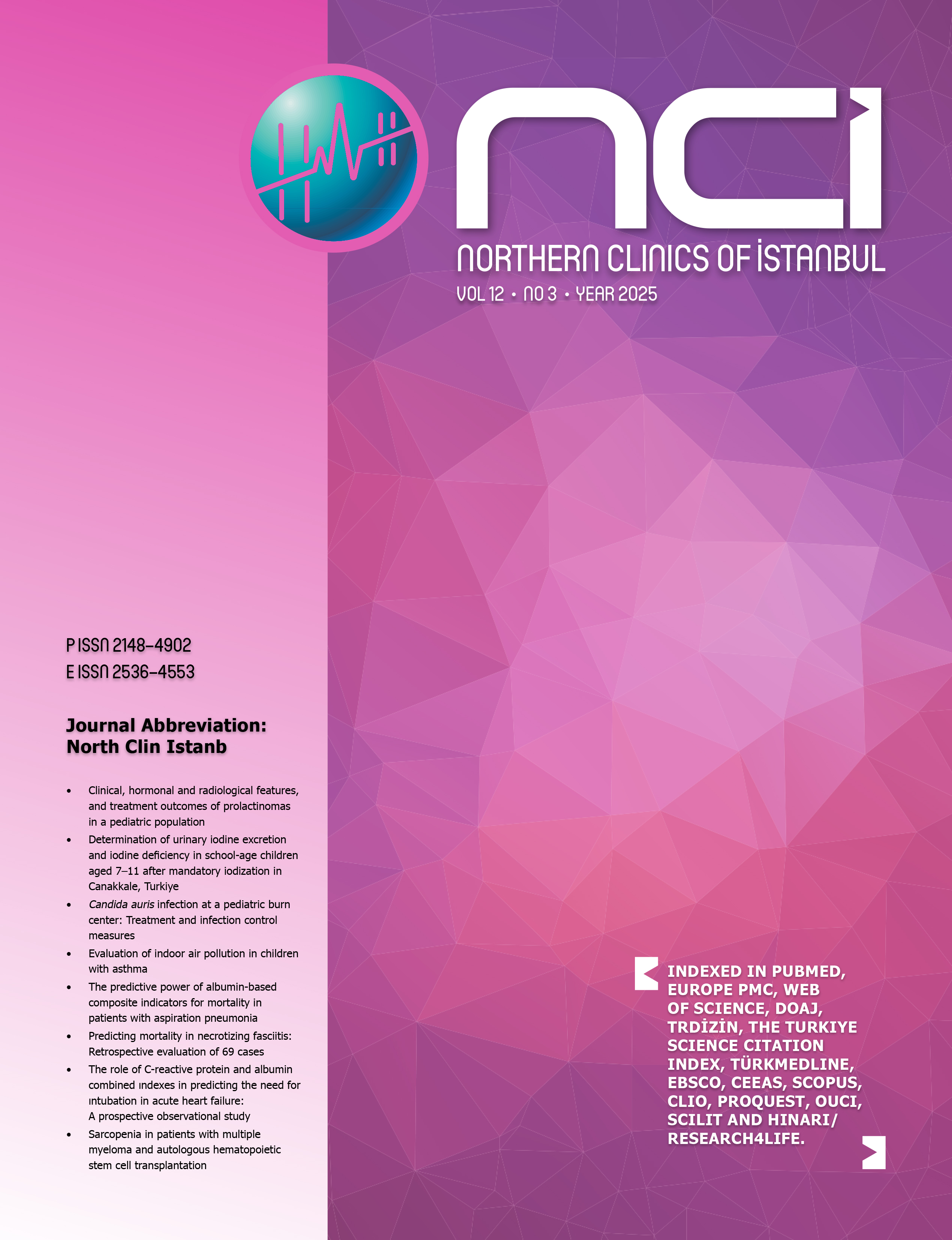Assessing the efficacy of the shock index in predicting mortality in patients with intracerebral hemorrhage
Aysenur Onalan1, Bengu Mutlu Saricicek21Department of Neurology, University of Health Sciences, Kartal Dr. Lutfi Kirdar City Hospital, Istanbul, Turkiye2Department of Emergency Medicine, University of Health Sciences, Kartal Dr. Lutfi Kirdar City Hospital, Istanbul, Turkiye
OBJECTIVE: It has been reported that the shock index assists in the prediction of poor prognosis in stroke patients. However, the role of this index in predicting mortality and prognosis in patients with intracerebral hemorrhage has not been sufficiently investigated. The objective is to examine the correlation between the shock index and mortality and unfavorable clinical outcomes in individuals with intracerebral hemorrhage.
METHODS: 110 consecutive cases of intracerebral hemorrhage were evaluated in the emergency department. The shock index values of the patients were calculated using their initial blood pressures and HR. For descriptive purposes, the shock index values were categorized into three groups: <0.50, 0.500.70, and >0.70. The relationships of these three values and the mean shock index with hematoma volume, hematoma rupturing into the ventricle, length of hospital stay, complications during this period, and in-hospital and three-month mortality were examined.
RESULTS: There were 58 male patients in this study, with a mean age of 62.66±13.64 years. The mean baseline Glasgow Coma Scale score was 13.78±2.37, and the mean baseline shock index value was 0.51±0.13. The mean time of hospitalization was estimated to be 17.01±14.02 days. The mean in-hospital mortality rate was 19%, and the mean three-month mortality rate was 23%. No statistically significant differences were found in hematoma volume, hematoma rupturing into the ventricle, length of hospital stay, complications during this period, or in-hospital and three-month mortality according to the mean shock index value or shock index categories (<0.50, 0.500.70, and >0.70).
CONCLUSION: The shock index evaluated in the emergency department in patients with intracerebral hemorrhage is not related to mortality or morbidity.
İntraserebral kanamalı hastalarda mortaliteyi öngörmede şok indeksinin etkinliğinin değerlendirilmesi
Aysenur Onalan1, Bengu Mutlu Saricicek21Sağlık Bilimleri Üniversitesi, Kartal Dr. Lütfi Kırdar Şehir Hastanesi, Nöroloji Kliniği, İstanbul2Sağlık Bilimleri Üniversitesi, Kartal Dr. Lütfi Kırdar Şehir Hastanesi, Acil Tıp Kliniği, İstanbul
Amaç: Şok indeksinin inmeli hastalarda kötü prognozu öngörmeye yardımcı olduğu rapor edilmiştir. Ancak bu indeksin intraserebral kanamalı hastalarda mortalite ve prognozu öngörmedeki rolü yeterince araştırılmamıştır. Bu çalışmanın amacı intraserebral kanamalı hastalarda şok indeksi ile mortalite ve kötü klinik sonuçlar arasındaki ilişkiyi araştırmaktır.
Yöntem: Acil serviste ardışık 110 intraserebral kanama olgusu değerlendirildi. Hastaların şok indeksi değerleri, giriş kan basınçları ve kalp atım hızları kullanılarak hesaplandı. Tanımlayıcı amaçlar doğrultusunda şok indeksi değerleri üç gruba ayrıldı: <0,50, 0,50-0,70 ve >0,70. Bu üç değer ile ortalama şok indeksinin hematom hacmi, ventriküle açılan hematom, hastanede kalış süresi, ve bu süreçteki komplikasyonlar, hastane içi ve üç aylık mortalite ile ilişkileri incelendi.
Bulgular: Hastaların 58'i erkek, 33'ü kadın olup yaş ortalaması 62,66±13,64 yıl idi. Ortalama başlangıç Glasgow Koma Skalası skoru 13,78±2,37 ve ortalama başlangıç şok indeksi değeri 0,51 ± 0,13 idi. Ortalama hastanede kalış süresi 17,01±14,02 gündü. Ortalama hastane içi ölüm oranı %19, ortalama üç aylık ölüm oranı ise %23 idi. Ortalama şok indeksi değeri veya şok indeksi kategorilerine göre(<0,50, 0,50-0,70 ve >0,70) hematom hacmi, hematomun ventriküle rüptüre olması, hastanede kalış süresi, bu dönemdeki komplikasyonlar veya hastane içi ve üç aylık mortalite açısından istatistiksel olarak anlamlı bir farklılık bulunmadı.
Sonuç: İntraserebral kanamalı hastalarda acil serviste değerlendirilen şok indeksinin mortalite veya morbidite ile ilişkisi yoktur. (NCI-2024-3-8)
Manuscript Language: English





















